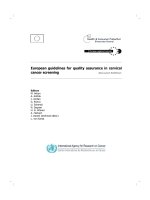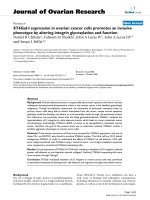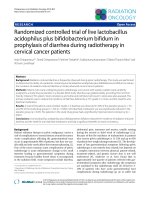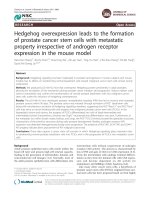MiR-23b controls ALDH1A1 expression in cervical cancer stem cells
Bạn đang xem bản rút gọn của tài liệu. Xem và tải ngay bản đầy đủ của tài liệu tại đây (2.12 MB, 6 trang )
Wang et al. BMC Cancer (2017) 17:292
DOI 10.1186/s12885-017-3192-x
RESEARCH ARTICLE
Open Access
MiR-23b controls ALDH1A1 expression in
cervical cancer stem cells
Weiwen Wang1,2†, Yang Li1†, Na Liu3, Yu Gao1 and Long Li1*
Abstract
Background: Cancer stem cells has been widely investigated due to its essential role in cancer progression and
drug resistance. Here, we try to find a new therapeutic target for cervical cancer stem cells.
Methods: We detected ALDH1A1-associated miRNAs expression in our isolated tumorspheres and their
corresponding parental cells. Sphere formation assay was also used to determine stemness after cells were
manipulated with miR-23b plasmid or miR-23b inhibitor.
Results: We found that miR-23b was under-expressed in cervical cancer stem cells to maintain high levels of
ALDH1A1. Introduction of miR-23b into cervical cancer cells could alter stemness and cisplatin sensitivity.
Conclusions: miR-23b plays key role in maintaining stemness of cervical cancer stem cells and can be developed as
therapeutic target to better fight against cervical cancer.
Keywords: miR-23b, Cervical cancer stem cells, ALDH1A1
Background
Cervical cancer is the major leading cause of cancerrelated death in women worldwide. Annually, about
530,000 new cases of cervical cancer are documented,
which puts people’s health into threat [1, 2]. Clinical and
experimental evidence suggest that the infection of HPV
is highly associated with the initiation and progression
of cervical cancer [3, 4]. HPV-induced overexpression of
E6 and E7 is the oncogenic stimulus to drive cervical
cancer progression [1]. E6 forms complex with p53 and
targets it via proteasome-mediated degradation, while E7
interacts and inactivates pRb, leading to the release of
transcription factor E2F [5, 6]. Besides, other signaling
pathways such as MAPK, PI3K, EGFR cassette are also
involved in cervical carcinogenesis [1, 7–9]. Although
standard treatments such as chemotherapy, radiotherapy
and surgery have shown promising effect [10, 11],
advanced tumor is observed in approximate 50% of
patients. The increased population of cancer stem cells
is one of mechanisms that promotes cervical cancer to
advanced stage.
* Correspondence:
†
Equal contributors
1
Department of Gynecology and Obstetrics, First Affiliated Hospital, Xi’an
Jiaotong University, 277 West Yanta Road, 710061, Xi’an, China
Full list of author information is available at the end of the article
Cancer stem cells (CSCs) are small population that
can self-renew and differentiate into cancerous cells if
necessary [12, 13]. Just like other CSCs, Cervical cancer
stem cells (CCSCs) are blinded to chemotherapy or radiation [14]. Evidence suggest that the recurrence of cervical cancer after remission is attributable to the failure
of targeting CCSCs. As an intracellular enzyme that has
a detoxifying role, ALDH1A1 has been identified as cancer stem cells marker for cervical cancer [15]. However,
the detailed mechanisms responsible for higher expression of ALDH1A1 in CCSCs are largely unknown.
MiRNAs are short non-coding RNA molecules, usually
21–25 in length, which are processed from pri-miRNA
and pre-miRNA by Drosha and Dicer, respectively [16].
The major biological function of miRNA is to titrate
mRNA by directly binding its 3’UTR, leading to its degradation or translational suppression [16]. Growing evidence suggest that miRNAs are implicated into the
pathogenesis of human diseases or cancers, including
cervical cancer [17]. For instance, miR-150 promotes
cervical cancer proliferation via degrading FOXO4 while
miR-302 suppresses its growth by reducing AKT1 levels
[18, 19].
In this study, we found that miR-23b was downregulated in Hela and CaSki cervical cancer stem cells
© The Author(s). 2017 Open Access This article is distributed under the terms of the Creative Commons Attribution 4.0
International License ( which permits unrestricted use, distribution, and
reproduction in any medium, provided you give appropriate credit to the original author(s) and the source, provide a link to
the Creative Commons license, and indicate if changes were made. The Creative Commons Public Domain Dedication waiver
( applies to the data made available in this article, unless otherwise stated.
Wang et al. BMC Cancer (2017) 17:292
derived from tumorspheres. MiR-23b directly binds to
the 3’UTR of ALDH1A1 to suppress its translation. Importantly, targeted expression of miR-23b could disrupt
the stemness of CCSCs while miR-23b inhibitor increased
the population of cervical tumorspheres. Meanwhile, miR23b could alter the sensitivity of cervical cells to cisplatin
treatment. Collectively, our data indicate that miR-23b
may serve as cancer stem cell marker form cervical cancer
and could be developed as therapeutic target.
Methods
Cell culture
Hela, CaSki, Siha and C33A cells were purchased from the
American Type Culture Collection (ATCC, Manassas, VA,
USA) and maintained in Dulbecco’s Modified Eagle’s
Medium (Invitrogen, Grand Island, NY, USA) supplemented with 10% FBS, penicillin (100 units/ml), streptomycin (100 μg/ml), 1% L-glutamine. All cell lines were
cultured in a 5% CO2 humidified incubator at 37 °C.
Western blotting
Cells were lysed in RIPA buffer (50 mM Tris–HCl/
pH 7.4, 1% NP-40, 150 mM NaCl, 1 mM EDTA, 1 mM
PMSF, 1 mM Na3VO4, 1 mM NaF, 1 mM okadaic acid
and 1 mg/ml aprotinin, leupeptin and pepstatin). Equal
amount of proteins was loaded and separated on 8–10%
SDS/PAGE gel and then transferred onto PVDF membranes (Millipore, Billerica, MA). After blocking in
5%BSA, the membranes were incubated with appropriate
dilutions of specific primary antibodies overnight at 4 °C,
followed by incubation of secondary antibody for 1 h at
room temperature. Antibodies used in this study were:
ALDH1A1 (Ab52492, Abcam), GAPDH (8C2, Santa Cruz).
Luciferase assay
PLKO-miR-23b or PLKO bearing Hela cells were transfected with pGL3–3’UTR-ALDH1A1 or its mutated one
(100 ng/well) using the Lipofectamine 3000 transfection
reagent (Invitrogen, Carlsbad, CA), pRL-TK (10 ng/well)
was used as transfection control. After 24 h transfection,
cells were lysed for Dual-Luciferase Reporter Assay
detection (Promega, Madison, WI)) according to the
manufacturer’s protocol.
Site directed mutagenesis
Briefly, PCR was conducted in 20 μL volume system:
50 ng DNA template (pGL3–3’UTR-ALDH1A1), 2 μL
10XPhusion buffer, 0.25 μL Phusion enzyme, 1 μL
10 μM forward or reverse primer. The reaction was done
as follows: 98 °C 5 mins, 30 cycles of: 98 °C 30s, 60 °C
30s, 72 °C 2 mins. PCR products was digested with Dpn
I and subjected to PNK treatment, then was ligated with
T4 ligase before transformation. Mutated clone was confirmed by Hind III restriction enzyme. The primers used
Page 2 of 6
in mutagenesis is: forward, 5′-TTGCAAACCCCCA
AGTCCTATCCTA;
reverse, 5′-TCAGAAGGCAAATAATTCTTTCAG.
RNA isolation and real time PCR
total RNAs were isolated using Trizol reagent (Invitrogen, Grand Island, NY). 1 μg of total RNA was subjected
to reverse transcription using Superscript III transcriptase (Invitrogen, Grand Island, NY). Quantitative realtime PCR (qRT-PCR) was conducted using a Bio-Rad
CFX96 system with SYBR green to determine the mRNA
expression level of a gene of interest. The reverse transcription of MiRNAs was performed: 1) poly A addition:
1 unit of Poly (A) polymerase with 1 mM ATP in 1xRT
buffer at 37 °C for 10 min in 10 μl volume, and then
heat inactivate at 95 °C for 2 min, 2) Primer anchor: add
50 mmol anchor primer to 12.5 μl, incubate at 65 °C for
5 min, 3) cDNA synthesis: add 2 μl 5× RT buffer, 2 μl
10 mM dNTP, 1 μl reverse transcriptase to total 20 μl,
incubate at 42 °C for 1 h. Quantitative real-time PCR
(qRT-PCR) of miRNA was conducted using the Taqman
probe. U6 was served as control.
Sphere formation assay
5 × 103 cells were mixed with equal amount of growth
factor enriched matrigel. 100 μL mixture was seeded
into 24-well plate and supplemented with 1 mL medium.
After 2 weeks later, floating cells were counted under
microscopic machine.
Statistics
Differences in mean values between two groups were analyzed by two-tailed Student’s t test and the data values
were presented as the mean ± SEM. p ≤ 0.05 was considered as statistical significance.
Results
MiR-23b is down-regulated in cervical cancer stem cells
ALDH1A1 has been proved as one marker for cervical
cancer stem cells. We hypothesized that the higher levels
of ALDH1A1 in cervical cancer stem cells are partially
attributable to the deregulation of miRNAs. For this end,
we isolated miRNAs from sphere- forming cells, which
were verified by stem cell markers: Nanog, Oct4, CD44
and Sox2 (Fig. 1a), and compared their expression levels
to the corresponding partners in parental cells. Using
two miRNA prediction programs, we finally focused on
13 miRNAs because they are predicted by both programs
to target ALDH1A1 (Fig. 1b). Results showed that miR23b was consistently down-regulated in sphere-forming
cells derived from four cervical cancer cells (Fig. 1c, d and
Additional file 1: Figure S1), suggesting that it may be
good candidate for targeting ALDH1A1.
Wang et al. BMC Cancer (2017) 17:292
Page 3 of 6
Fig. 1 MiR-23b was down-regulated in sphere-forming cells. a. confirmation of sphere-forming cells as cancer stem cells by using several markers:
Nanog, Oct4, CD44 and Sox2. Genes were normalized to GAPDH. b. TargetScan and MicroRNA.Org were performed to predict miRNAs for
ALDH1A1. c. The expression of predicted miRNAs between tumorsphere cells and parental cells in Hela. d. The predicted miRNAs (c) in between
tumorsphere cells and parental cells in CaSki. Data is presented as mean ± SEM. *P < 0.05; **P < 0.01; ***P < 0.001
MiR-23b directly binds to the 3’UTR of ALDH1A1
To test whether miR-23b could decrease ALDH1A1 expression levels. We overexpressed miR-23b in Hela cells
and CaSki cells (Fig. 2a), finding that miR-23b indeed
bears the ability to reduce ALDH1A1 expression levels
in both Hela and CaSki cell lines (Fig. 2b). To examine
whether miR-23b exerts its degradation effect on
ALDH1A1 via binding to its 3’UTR, we cloned
luciferase-based 3’UTR of ALDH1A1 and found its activity can be reduced by miR-23b (Fig. 2c, d). Importantly, this reduced luciferase activity can be blocked
when the predicted binding site is mutated (Fig. 2c, d),
suggesting that miR-23b directly bind to the 3’UTR of
ALDH1A1 to cause its reduction.
MiR-23b re-sensitizes cervical cancer cells to cisplatin
treatment
MiR-23b could alter stemness of cervical cancer stem cells
Cisplatin treatment is one of options for advanced cervical
cancer [20, 21]. Numerous studies have proved that cancer
stem cells contribute to drug resistance including cisplatin
resistance [22]. To test whether miR-23b meditated stemness of cervical cancer stem cells is implicated into cisplatin sensitivity, we administrated various concentrations
of cisplatin into vector-bearing and miR-23b overexpressing Hela cells. Result demonstrated that miR-23b could
re-sensitize Hela cells to cisplatin treatment (Fig. 4a).
Similar result was obtained in CaSki cells (Fig. 4b).
On the contrary, miR-23b inhibitor could confer cisplatin resistance to both Hela and CaSki cells (Fig. 4c, d).
All these data suggest that miR-23b alters cisplatin sensitivity by affecting the population of cervical cancer stem
cells.
Since ALDH1A1 plays key role in maintaining the homeostasis of cervical cancer stem cell, we wanted to detect the
sphere-forming ability of cells which were transfected with
miR-23b. As shown in Fig. 3a, overexpression of miR-23b
in Hela cells dramatically reduce the size and number of
tumorspheres. Similar result was gained when Hela cells
were replaced by CaSki cells (Fig. 3b).
On the contrary, introduction of miR-23b inhibitor
into Hela cells bestowed them strong capacity of forming tumorspheres (Fig. 3c). We also observed similar
phenomenon in CaSki cells which were transfected with
miR-23b inhibitor (Fig. 3d).
Together, these data suggest that miR-23b could
change the stemness of cervical cancer stem cells, probably via inhibiting the expression of ALDH1A1.
Discussion
Cancer stem cells confer drug resistance to patients who
received conventional treatments such as chemotherapy
and radiotherapy. Here, by screening 13 miRNAs that
could predicatively bind the 3’UTR of ALDH1A1 for
RISC-mediated degradation, we found that miR-23b accordantly exhibits lower expression in sphere cells
derived from four cervical cancer cell lines (Hela,
CaSki, C33A and Siha), indicating the downregulation
of miR-23b is generally observed in cervical cancer
stem cells (CCSCs). Functionally, forced expression of
miR-23b could disrupt cancer stemness via suppressing
ALDH1A1 expression while addition of miR-23b inhibitor
bore the ability to increase cancer stem cells population.
Wang et al. BMC Cancer (2017) 17:292
Page 4 of 6
Fig. 2 MiR-23b directly suppresses ALDH1A1 expression via base-pairing to its 3’UTR. a. Overexpression efficiency of miR-23b in Hela and CaSki
cells. b. ALDH1A1 was suppressed by overexpressing miR-23b in Hela and CaSki cells. GAPDH was used as loading control. c. Schematic map of
miR-23b binding seed on 3’UTR of ALDH1A1. d. 3’UTR binding assay to confirm miR-23b directly interacts with 3’UTR of ALDH1A1. Data is presented as
mean ± SEM. *P < 0.05; **P < 0.01; ***P < 0.001
Fig. 3 MiR-23b could alter the stemness of cervical cancer stem cells. a-b. Forced expression into Hela cells a and CaSki cells b reduced the
number of tumorspheres. c-d Addition of miR-23b inhibitor into Hela cells c and CaSki cells d increased the number of tumorspheres. Data is
presented as mean ± SEM. *P < 0.05; **P < 0.01; ***P < 0.001
Wang et al. BMC Cancer (2017) 17:292
Page 5 of 6
Fig. 4 MiR-23b confers cisplatin sensitivity to cervical cancer cells. a-b. Introduction of miR-23b into Hela cells a and CaSki cells b sensitized cells
to cisplatin treatment. c-d. Addition of miR-23b inhibitor into Hela cells c and CaSki cells d makes cells more resistant to cisplatin treatment. Data
is presented as mean ± SEM. *P < 0.05; **P < 0.01; ***P < 0.001
3’UTR binding assay also confirmed that miR-23b indeed
directly binds to ALDH1A1 mRNA, which could be attenuated by destroying the binding motif. Importantly, miR23b mediated reduction of cervical cancer stem cells also
contributed to cisplatin sensitivity.
According to our data, miR-23b plays role in altering
cell sensitivity to cisplatin treatment, probably due to
the consequence of the changed population of CCSCs.
Since CCSCs are inherently blinded to chemotherapy or
radiation, we believe that miR-23b still can alter radiation sensitivity of cervical cancer cells, which requires
future investigation. In addition, it is appealing to see
whether the expression levels of miR-23b is silenced in
cisplatin resistant cervical cancer cells (Cis-res CCCs)
and whether addition of miR-23b mimic could resensitizes Cis-res CCCs to cisplatin treatment.
Serval reports have demonstrated that miR-23b is
down-regulated in HPV-induced cervical cancer and this
regulation is dependent of p53, which can bind to the
promoter of miR-23b and trans-activate miR-23b expression [23]. As we known, p53 undergoes degradation
upon HPV infection. Of note, p53 is inactivated in
CCSCs for the maintenance of stemness. We postulate
that under-expression of miR-23b in CCSCs is regulated
at least partially by inactivation of p53. Additionally, one
study has pointed that the promoter of miR-23b is the
potential methylation target [24]. Therefore, the further
suppressed expression of miR-23b in CCSCs is possibly
regulated by methylation modification. MiR-23b has
been proved as tumor suppressive miRNA in many cancers. In gastric carcinoma, forced expression of miR-23b
inhibits proliferation, invasion, epithelial-mesenchymal
transition (EMT) and tumorsphere formation of gastric
cancer cells via targeting Notch2 receptor [25]. MiR-23b
also can target cyclin G1 to suppress ovarian cancer progression [26]. Finally, prostate cancer tumorigenesis is
highly associated with miR-23b levels, which base-pairs
with 3’UTR of Src to inhibit its translation [27]. Here,
we first showed that ALDH1A1 is additional target for
miR-23b, indicating that miR-23b exerts its functions via
affecting numerous genes’ expression. Of note, miR-23b
has been shown to be downregulated in cervical cancer
cells due to the hypermethylation at its promoter locus.
To supplement previous finding, we found that miR-23b
is further reduced in isolated tumorspheres, for the purpose of maintaining ALDH1A1 levels and cells’ stemness. Therefore, developing miR-23b as therapeutic
target will better battle against cervical cancer.
Conclusion
We found that miR-23b is under-expressed in sphere cells
compared to the parental cells, which contributes to the
higher expression levels of ALDH1A1 in sphere cells.
Forced expression of miR-23b has capacity to reduce the
number of tumorspheres, re-sensitizing cells to cisplatin
treatment. All data suggest that there is need to develop
miR-23b as therapeutic target for cervical cancer stem cells.
Additional file
Additional file 1: Figure S1. MiR-23b is under-expressed in tumorsphere cells derived from Siha and C33A cells. Data is presented as
mean ± SEM. *P < 0.05; **P < 0.01. (TIFF 613 kb)
Abbreviations
CSC: Cancer stem cell; CCSC: Cervical cancer stem cell
Wang et al. BMC Cancer (2017) 17:292
Acknowledgements
We thank the laboratory team for its collaboration.
Funding
None.
Availability of data and materials
All data supporting the conclusions are presented in this manuscript. The
corresponding author will provide the raw data and plasmids if there is a request.
Authors’ contributions
WW and YL performed experiments. NL and YG arranged the data and did
statistical analysis. LL designed experiments and wrote the manuscript.
All authors have read and approved the final manuscript.
Competing interests
The authors declare that they have no competing interests.
Consent for publication
Not applicable.
Ethics approval and consent to participate
Not applicable.
Publisher’s Note
Springer Nature remains neutral with regard to jurisdictional claims in
published maps and institutional affiliations.
Author details
1
Department of Gynecology and Obstetrics, First Affiliated Hospital, Xi’an
Jiaotong University, 277 West Yanta Road, 710061, Xi’an, China. 2Department
of Neurosurgery, Tangdu Hospital, Fourth Military Medical University, Xi’an,
China. 3Department of Ultrasound, The Second Affiliated Hospital, Xi’an
Jiaotong University, Xi’an, China.
Received: 7 July 2016 Accepted: 11 March 2017
References
1. Manzo-Merino J, Contreras-Paredes A, Vazquez-Ulloa E, Rocha-Zavaleta L,
Fuentes-Gonzalez AM, Lizano M. The role of signaling pathways in cervical
cancer and molecular therapeutic targets. Arch Med Res. 2014;45(7):525–39.
2. Siegel RL, Miller KD, Jemal A. Cancer statistics, 2016. CA Cancer J Clin. 2016;
66(1):7–30.
3. Thomas M, Narayan N, Pim D, Tomaic V, Massimi P, Nagasaka K, Kranjec C,
Gammoh N, Banks L. Human papillomaviruses, cervical cancer and cell
polarity. Oncogene. 2008;27(55):7018–30.
4. Yim EK, Park JS. The role of HPV E6 and E7 oncoproteins in HPV-associated
cervical carcinogenesis. Breast Cancer Res Treat. 2005;37(6):319–24.
5. Thomas M, Pim D, Banks L. The role of the E6-p53 interaction in the
molecular pathogenesis of HPV. Oncogene. 1999;18(53):7690–700.
6. Bernard X, Robinson P, Nomine Y, Masson M, Charbonnier S, Ramirez-Ramos
JR, Deryckere F, Trave G, Orfanoudakis G. Proteasomal degradation of p53
by human papillomavirus E6 oncoprotein relies on the structural integrity of
p53 core domain. Plos One. 2011;6(10):e25981.
7. Wu J, Chen C, Zhao KN. Phosphatidylinositol 3-kinase signaling as a
therapeutic target for cervical cancer. Curr Cancer Drug Targets. 2013;13(2):
143–56.
8. Branca M, Ciotti M, Santini D, Bonito LD, Benedetto A, Giorgi C, Paba P,
Favalli C, Costa S, Agarossi A, et al. Activation of the ERK/MAP kinase
pathway in cervical intraepithelial neoplasia is related to grade of the lesion
but not to high-risk human papillomavirus, virus clearance, or prognosis in
cervical cancer. Am J Clin Pathol. 2004;122(6):902–11.
9. Bumrungthai S, Munjal K, Nandekar S, Cooper K, Ekalaksananan T, Pientong
C, Evans MF. Epidermal growth factor receptor pathway mutation and
expression profiles in cervical squamous cell carcinoma: therapeutic
implications. J Transl Med. 2015;13:244.
10. Glick SB, Clarke AR, Blanchard A, Whitaker AK. Cervical cancer screening,
diagnosis and treatment interventions for racial and ethnic minorities: a
systematic review. J Gen Intern Med. 2012;27(8):1016–32.
Page 6 of 6
11. Schreuder SM, Lensing R, Stoker J, Bipat S. Monitoring treatment response
in patients undergoing chemoradiotherapy for locally advanced uterine
cervical cancer by additional diffusion-weighted imaging: A systematic
review. J Magn Reson Imaging. 2015;42(3):572–94.
12. Kreso A, Dick JE. Evolution of the cancer stem cell model. Cell Stem Cell.
2014;14(3):275–91.
13. Nguyen LV, Vanner R, Dirks P, Eaves CJ. Cancer stem cells: an evolving
concept. Nat Rev Cancer. 2012;12(2):133–43.
14. Chhabra R. Cervical cancer stem cells: opportunities and challenges. J
Cancer Res Clin Oncol. 2015;141(11):1889–97.
15. Douville J, Beaulieu R, Balicki D. ALDH1 as a functional marker of cancer
stem and progenitor cells. Stem Cells Dev. 2009;18(1):17–25.
16. Ha M, Kim VN. Regulation of microRNA biogenesis. Nat Rev Mol Cell Biol.
2014;15(8):509–24.
17. Banno K, Iida M, Yanokura M, Kisu I, Iwata T, Tominaga E, Tanaka K, Aoki D.
MicroRNA in cervical cancer: OncomiRs and tumor suppressor miRs in
diagnosis and treatment. Sci World J. 2014;2014:178075.
18. Li J, Hu L, Tian C, Lu F, Wu J, Liu L. microRNA-150 promotes cervical cancer
cell growth and survival by targeting FOXO4. BMC Mol Biol. 2015;16:24.
19. Cai N, Wang YD, Zheng PS. The microRNA-302-367 cluster suppresses the
proliferation of cervical carcinoma cells through the novel target AKT1. RNA.
2013;19(1):85–95.
20. Tan S, Hougardy BM, Meersma GJ, Schaap B, de Vries EG, van der Zee AG,
de Jong S. Human papilloma virus 16 E6 RNA interference enhances
cisplatin and death receptor-mediated apoptosis in human cervical
carcinoma cells. Mol Pharmacol. 2012;81(5):701–9.
21. Sahin K, Tuzcu M, Basak N, Caglayan B, Kilic U, Sahin F, Kucuk O.
Sensitization of Cervical Cancer Cells to Cisplatin by Genistein: the Role of
NFkappaB and Akt/mTOR Signaling Pathways. J Oncol. 2012;2012:461562.
22. Shen DW, Pouliot LM, Hall MD, Gottesman MM. Cisplatin resistance: a
cellular self-defense mechanism resulting from multiple epigenetic and
genetic changes. Pharmacol Rev. 2012;64(3):706–21.
23. Au Yeung CL, Tsang TY, Yau PL, Kwok TT. Human papillomavirus type 16 E6
induces cervical cancer cell migration through the p53/microRNA-23b/urokinasetype plasminogen activator pathway. Oncogene. 2011;30(21):2401–10.
24. Campos-Viguri GE, Jimenez-Wences H, Peralta-Zaragoza O, TorresAltamirano G, Soto-Flores DG, Hernandez-Sotelo D, Alarcon-Romero Ldel C,
Jimenez-Lopez MA, Illades-Aguiar B, Fernandez-Tilapa G. miR-23b as a
potential tumor suppressor and its regulation by DNA methylation in
cervical cancer. Infect Agents Cancer. 2015;10:42.
25. Huang TT, Ping YH, Wang AM, Ke CC, Fang WL, Huang KH, Lee HC, Chi CW,
Yeh TS. The reciprocal regulation loop of Notch2 pathway and miR-23b in
controlling gastric carcinogenesis. Oncotarget. 2015;6(20):18012–26.
26. Yan J, Jiang JY, Meng XN, Xiu YL, Zong ZH. MiR-23b targets cyclin G1 and
suppresses ovarian cancer tumorigenesis and progression. J Exp Clin Cancer
Res. 2016;35:31.
27. Majid S, Dar AA, Saini S, Arora S, Shahryari V, Zaman MS, Chang I, Yamamura
S, Tanaka Y, Deng G, et al. miR-23b represses proto-oncogene Src kinase
and functions as methylation-silenced tumor suppressor with diagnostic
and prognostic significance in prostate cancer. Cancer Res. 2012;72(24):
6435–46.
Submit your next manuscript to BioMed Central
and we will help you at every step:
• We accept pre-submission inquiries
• Our selector tool helps you to find the most relevant journal
• We provide round the clock customer support
• Convenient online submission
• Thorough peer review
• Inclusion in PubMed and all major indexing services
• Maximum visibility for your research
Submit your manuscript at
www.biomedcentral.com/submit









